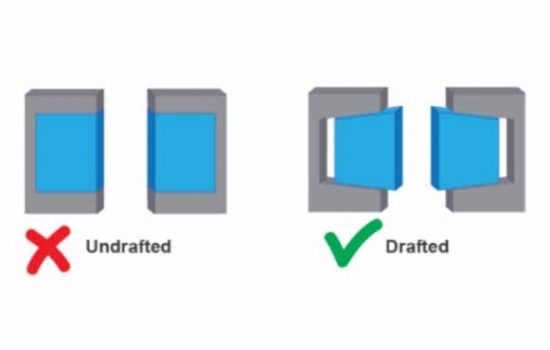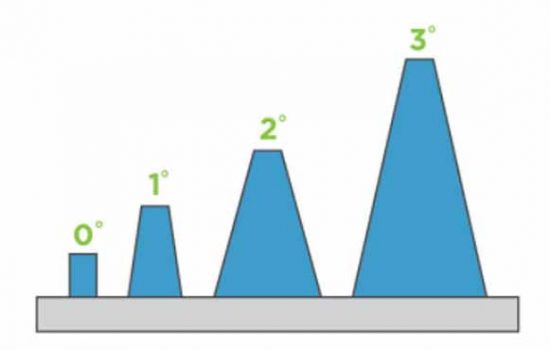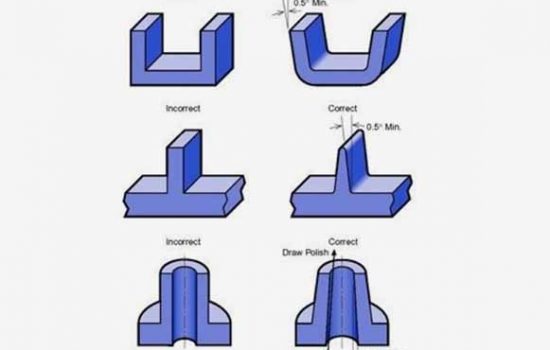Injection molding comprises a series of different steps that each contribute towards the formation of parts. They have been perfected over many years and even with new technology, the original injection concept remains largely the same. In this instance, we delve into the draft angle aspect of injection molding. What is it? Why is it so important and do you really have to adhere to it? Let us get right into it.

Source: 3space.com
A draft angle is a slope that is added along the vertical walls of a part to reduce resistance during the ejection process. To put it in perspective, take for example that you are manufacturing a beaker. As opposed to the exterior walls of the beaker sloping at a perpendicular 180° they would slope at 181°. This slope would be towards the mold’s parting line. It is recommended that it be included during the design of the part so that the injection mold is also designed accordingly.

Source: Pixabay
When molten plastic is injected into a mold, it settles and begins to cool. As it cools, plastic has a tendency to shrink towards the mold’s center of gravity. Some of the plastic may, therefore, pull away from the wall of the mold but most remains in contact with the wall.
During ejection, ejector pins slowly push the formed part upwards to try and nudge it out of the mold. As the part moves, its formed walls would scrape against those of the mold. This causes friction which:
Further, as the part is being pushed out of the mold, air is equally displaced. This could form a vacuum. If the part remains stuck due to friction and the ejector pins keep pushing upwards, the vacuum exerts a suction force and the structure of the part could become warped.
In summary, at this point, you would have a warped part with scraped exterior walls. It is unlikely that it would pass quality tests. Alternatively, you could stop the ejection immediately you notice resistance and wait for the part to cool a bit longer and contract. This would, however, increase your cycle times and possibly your production costs yet it is not a full-proof solution.
`When a draft angle is added to the design of a mold, it solves all these problems. The slope creates some room for the plastic to shrink without getting stuck to the walls of the mold. In turn, there is less friction during the ejection process and no scraping of walls. Smoother ejection also eliminates the problem of suction force and the subsequent warping of the part.

Source: www.protolabs.com
The general rule is to add a minimum of 1° of draft for every inch of depth in a mold cavity. You could add up to 2° but, aside from depth, other factors influence the size and effectiveness of a draft angle. They include:
The material – thermoplastic materials are not the same. Some shrink more than others while some like nylon are low-friction materials that may not even require a draft angle. As such, the characteristics of the material you are using ought to guide you in deciding how much draft is necessary.
The desired finish – if you would like a part to have a smooth finish, you may need a considerable draft of about 1.5° to 2° so that the walls are not scraped during ejection. If you are aiming for walls with texture you may need even more draft than that used for smooth walls. This is because a rough texture causes even more friction force thereby causing ejector pins to experience more resistance.
The size of the part – larger parts are heavier and weight generally increases friction. Moreover, they occupy a larger surface area in their larger molds. There would, therefore, be more areas of contact experiencing resistance during ejection. Due to these reasons, larger parts would require more degrees of draft; an extra degree for each inch of depth would suffice.

Source: Pinterest
It is one thing to understand draft angles, it is another to implement them correctly during your injection molding processes. Beyond calculating the draft angle, here are some guidelines that could help you get a better sense of how to navigate implementation.
Consider the ejection system to be used – some ejection systems are more powerful than others. If you have access to a more powerful ejection system, this means that it would be able to overcome any friction force. You would thus only need a minimal draft adjustment to preserve the surface finish of the part and to prevent vacuum push-back.
Incorporate the draft angle as early as possible in the design process – draft angles alter the design of a part albeit not by much. Still, this alteration could have a ripple effect on other crucial factors such as structural stability and whether the part will be compatible with other components. For instance, if the part you are drafting will be paired with a lid, will the lid still fit right after the draft angle is implemented? Addressing these issues during the design stage and prototyping designs to test their viability could save you lots of time and money.
Implement the draft angle for all components- all surfaces that are in contact with the mold are subject to friction and all the challenges that come with the lack of a draft angle. It would defeat the purpose if some parts are drafted while others are not. To truly gain the expected advantages, ensure that the draft angle is implemented with consistency for all parts.
Some parts require draft angles inside and out –this mostly applies to parts that are hollow in the middle like a beaker. Due to their design, they usually have contact with the mold within the interior walls and on the outside as well. As such, they would experience resistance in both areas during part release. To avoid this, it would be advisable to implement a draft angle on both sides of their walls.
The draft angle should be in harmony with the piece’s design – the design of a piece is based on functionality and aesthetics. A draft angle should be implemented in a way that preserves these two core aspects of design. If it takes away aesthetic or functional value perhaps the design should be reevaluated altogether.
It is best to involve all production stakeholders in the design and drafting process- injection molding involves multiple steps and each falls under its own department. First, the creative team and engineers come up with a structure. Both of these departments would have to work with a mold manufacturer to come up with a mold for production. If communication is ineffective or the teams do not consult each other for input, the design and mold-making stages could go on for a very long time and cost way more than they should have.
Draft angles are a necessity- the success of injection molding processes is significantly dependent on draft angles. They are neither decorative nor a production luxury. Rather, they are a necessity that helps save production time, reduce wastage due to reject products and mitigate production costs.

Source: Pixabay
Like everything under the sun, there are upsides and downsides to draft angles. They include:
Pros:
Draft angles reduce production cycle times
They help deliver the desired surface finishes on parts
They protect molds from undue wear and tear
Draft angles eliminate the need for complex and costly ejection systems
They yield more even and better quality parts because they mitigate shrinkage
Cons:
Draft angles can be complex to implement when designing parts and can also complicate mold design
Errors stemming from draft angles can be costly
There is no standard draft angle, it needs to be calculated for each design project
Sometimes despite all efforts draft angles can be limiting to creative design
At first encounter, draft angles can be challenging and may seem like an unnecessary hurdle in injection molding. You would, however, begin to see their value once you experience how much more difficult it is to produce parts without this slope adjustment. Finally, consider navigating the design process with an experienced injection molding manufacturer. It may ease your design process and give your team a chance to learn more about how to factor in draft angles in different projects.
+86-755-8524 1121
marketing@rydtooling.com
No. 2, HongKan 1st Road, YanChuan Community, YanLuo Street, BaoAn District, ShenZhen City, China. Post Code 518105.
Subscribe to our newsletter to get manufacturing news and updates!
